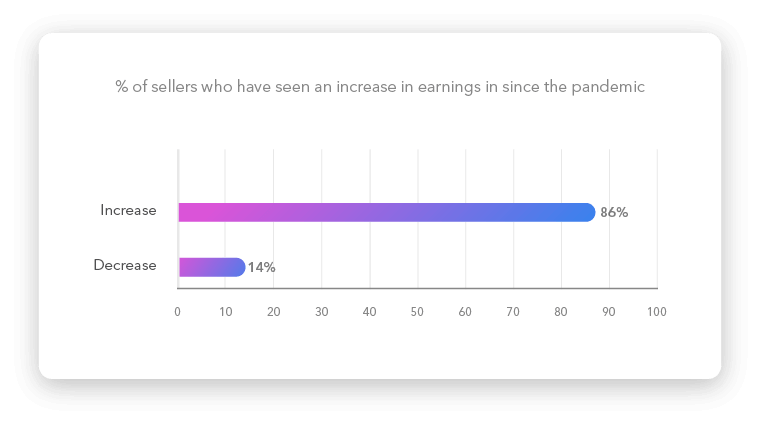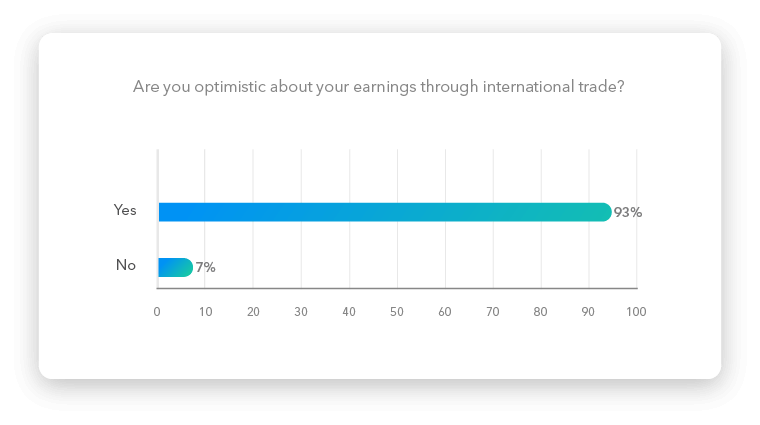Made in India for the World: The State of Indian Cross-Border eCommerce
The Indian eCommerce market has grown significantly in the last few years. As a result, many cross-border businesses have undergone a fast-paced digital transformation and contributed to surpassing the government-set $400 billion target of trade within a single year.

Introduction
This has partly been due to the ‘Make in India’ program, as well as shifting customer demands around the world. But as Indian cross-border merchants aim to thrive within rapidly changing market conditions, we set out to understand whether they feel confident to take a ‘Made in India’ product and succeed globally. If they do, what is it that gives them this confidence, and if not, which areas need improving, and how?
We surveyed Indian-based cross-border sellers in today’s post-pandemic world to uncover the key elements that have helped them succeed so far, and the challenges preventing them from being even more successful in the future.
As our findings show, Indian sellers have moved on from the pandemic and have made healthy progress thanks to the ‘Make in India’ program. They are up to the global challenge of providing quality products at competitive pricing and can easily match their biggest competitor, China. But when almost half of all respondents claim that the biggest weakness in Indian cross-border trade lies in marketing their products abroad, it’s clear there could be problems ahead if these are not addressed. Furthermore, with large ambitions to expand their reach by selling into the US, they will have to raise their game if they are to succeed in this notoriously competitive market and beyond.
Key Takeaways
- One in three Indian sellers think that marketing is their biggest weakness when it comes to selling an Indian-made product
- 42% of Indian sellers think that improvements are needed in promoting the ‘Make in India’ program globally
- 91% of Indian sellers are planning to expand their cross-border business
- 94% of Indian sellers think that ‘Make in India’ products are globally competitive
- 70% of India sellers think that the Quality of Indian-made products is what helps them in the international arena
What is the ‘Make in India’ program?
Created in 2014, the ‘Make in India’ program is an initiative of the Indian Government to encourage and incentivize Indian companies to develop, manufacture, assemble, and export products in India and sell them both internally and globally. The aim is to “transform India into a global design and manufacturing export hub”
Growth in the Indian eCommerce Landscape
Like much of the world, Indian eCommerce sellers saw an uptick in sales in recent years, with the Covid-19 pandemic serving as a catalyst for further online adoption by consumers. As shopping habits continue to shift towards digital channels, growing connectivity brought a boom to borderless economies, and Indian sellers saw more customers coming from around the world than ever.

In addition, the ‘Make in India’ campaign, pushed by the Indian government to encourage Indian sellers to reduce reliance on imports and increase domestic manufacturing, along with other government-backed programs, such as Aatmanirbhar Bharat which also seeks to boost India’s self-dependence and rely less on foreign products, has made significant contributions in boosting Indian production and cross-border commerce.
As a result, 86% of sellers reported an increase in earnings since the start of the pandemic, and a similar number are now looking to expand their business to new markets.

As possibly the most mature market for buying goods online, it comes as no surprise that over 73% of Indian sellers are eyeing the United States for their planned cross-border trade expansion.
The US is a highly prized market for almost every product, so it’s a natural choice for Indian sellers to aspire to. It’s also a market where English is a shared language, making it easier for Indian sellers to penetrate. And with a sizeable Indian community there, the US offers a large existing base of potential customers to buy and advocate for Indian made products.
But for similar reasons, it’s why many other cross-border sellers from all over the world also want a slice of the action, and why the competition is fierce.

Ambitions to succeed in the United States, arguably the most lucrative eCommerce market in the world, are promising considering that over 94% of Indian sellers feel that their ‘Made in India’ products are competitive on the global field.

The main driver of Indian confidence
Around the world, China remains the strongest challenger in eCommerce. With one in four products made there and massive economies of scale, China is hard to beat on pricing. As such, Indian sellers lean in on offering higher quality goods. This is the main driving force behind Indian sellers’ confidence in cross-border trade – 70% of Indian sellers believe it is the quality of their products that make them export successfully.

This emphasis on quality is also reflected in the Indian government’s ‘zero defect-zero effect’ policy, which demands that Indian manufacturers strive for excellence in production to compete globally.

India’s main weakness in cross-border trade
However, in understanding what is driving Indian sellers’ confidence in cross-border trade, we can also see their biggest concerns.
There is a significant lack of confidence in the marketing of ‘Make in India’ products. Only 1% of sellers believe their marketing makes them successful and 35% believe that marketing is their biggest weakness when it comes to selling an Indian made product.

Marketing: India’s Achilles heel
First, despite advancements in technology and manufacturing, Indian sellers face a barrier of mindsets from global customers. They feel that there is a common myth that Indian goods are low in quality and lack innovation, so sellers face a challenge in building trust and credibility amongst foreign buyers.
In addition, the need for localization poses marketing challenges. Indian sellers feel comfortable expanding into the United States and the UK due to a shared common language, but targeting customers across borders requires much more than translation. True localization, backed by good market research and cultural fit are critical when marketing to customers in these countries.
“There is a massive opportunity to build association of premium quality with “Made in India” products in specific categories on digital marketplaces. With such a marketing campaign, Indian products can enjoy a massive advantage and enjoy customer preference over products from other countries.”
Rohit Kulkarni
SVP of SAMENA, Payoneer
There’s always room for improvement
A large proportion of Indian sellers believe the government could do more to promote the ‘Make in India’ program internationally. This is followed by many who believe more can be done to improve India’s supply chain, such as improvements to physical infrastructure as well as the bureaucracy that administers it. And, with pricing being a constant pressure, financial incentives such as government subsidies could also provide critical support for Indian exporters trying to take on global competitors.

Another channel for Indian sellers to seek help from is the marketplaces themselves. Platforms like Amazon, Walmart, and eBay, where many Indian sellers are already marketing their products, offer a wide range of tools and services to help their sellers reach more customers and increase sales. From ad campaigns to product listing tools, there is a lot sellers can make use of to improve their listings.
Indian sellers have high hopes and optimism

Despite the challenges, 93% of sellers are optimistic about their future trade earnings. This is, in almost equal measure, due to the impact that government support, improved logistics, the global economy and ePayments have had on the way Indian sellers operate and manage their business. Interestingly, they don’t consider the resilience gained from the global pandemic as having much impact on their optimism and seem to have positively moved on from this global event.

Some Final Words
The ‘Make in India’ program is a key driver in encouraging Indian businesses to manufacture locally and sell globally. As one of the top five manufacturing countries in the world, when it comes to quality and pricing, Indian sellers are emboldened to take on their biggest rivals. They are confident that when it comes to quality, they have the upper hand.
Hitting $400 billion worth of cross-border trade in a single year is a significant and impressive milestone. But the potential growth is much bigger. So, when 42% of Indian sellers highlight the improvements that are needed in how the ‘Make in India’ program is promoted globally, and more than one in three identify marketing as their biggest weakness when it comes to selling an Indian-made product, it’s clear there still remains much work to do if Indian sellers are to take on their next cross-border target.
How Payoneer can help
If you’re an India-based eSeller, Payoneer is your go-to partner for managing all your business payments.
From multi-currency receiving accounts that enable you get paid from international marketplaces, to Capital Advance to help you invest in your business and bring it to the next level, Payoneer has a whole suite of tools to help.
Open an account today and see how easy, fast, and low-cost managing your business payments can be.
Related resources
Latest articles
-
Made in India for the World: The State of Indian Cross-Border eCommerce
The Indian eCommerce market has grown significantly in the last few years. As a result, many cross-border businesses have undergone a fast-paced digital transformation and contributed to surpassing the government-set $400 billion target of trade within a single year.
-
Defying the odds: How Ukrainian businesses thrive during war
One year post-war, Ukraine’s businesses adapt and thrive amidst adversity. Entrepreneurs showcase resilience, reflecting national tenacity. Many diversify, venturing into e-commerce and digital realms. Despite hurdles, 44% of SMBs aim for growth, with 36% hiring. Their grit underscores Ukraine’s enduring spirit amid challenges.
-
An 8-point Checklist for Finding the Best Payment Provider
There’s huge potential to expand into ASEAN markets. But only for online sellers that accept local payment methods. Finding a trusted payment solution can be a worry and a challenge. Use this checklist to vet potential payment partners. With the right payment support, the sky’s the limit!
-
How to bill your international clients
Want to learn how to bill international clients when you’re based in the Philippines? In this article we spoke to three leading business owners who shared their tips to working successful international work. Learn how they collect payments and more below.
-
How to nail your direct-to-consumer payment strategy
Asia-Pacific offers massive potential for DTC ecommerce. But cross-border payments can be a headache. We share an actionable strategy for DTC payments that’ll remove DTC payment hazards and expand your business with ease. What are you waiting for?
-
How to pay international vendors in order to promote profits and reduce risk
In this article, we’ll share our expert tips and best practices for paying international vendors, so you can focus on growing your business. From choosing the right payment method to navigating currency exchange, we’ve got you covered.














